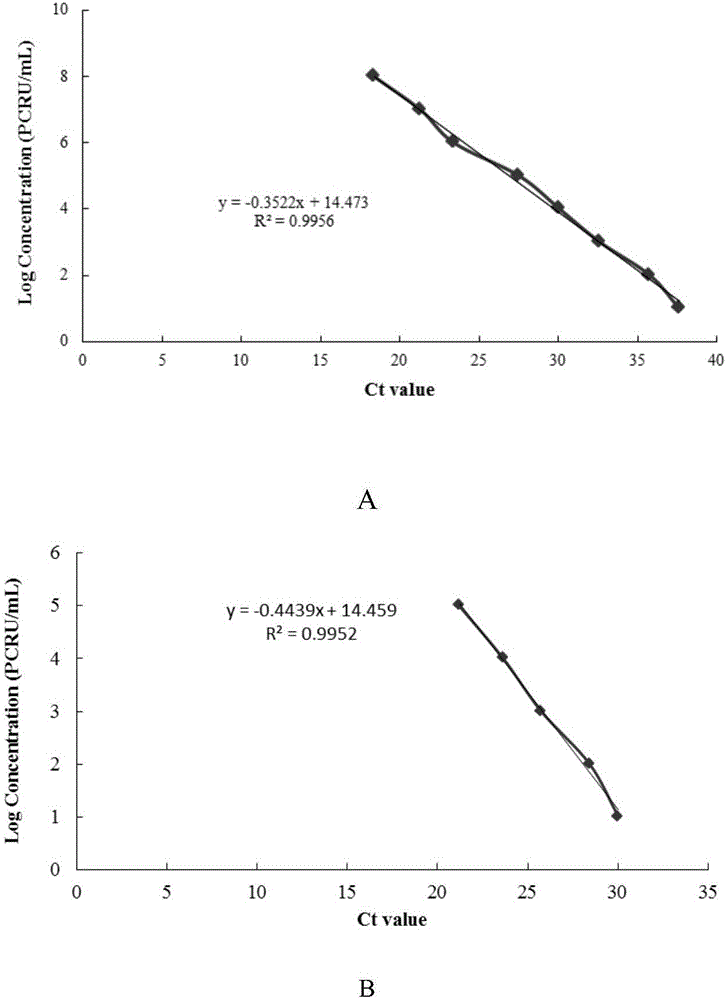Method for detecting norovirus in food based on negatively charged membrane concentration
A membrane concentration and negative charge technology, applied in the field of food norovirus elution and adsorption, can solve the problems of different concentration methods, different results, different physical and chemical properties, and incomparability, etc., to achieve the virus elution rate and detection. The effect of improving the detection rate, good repeatability and improving detection sensitivity
- Summary
- Abstract
- Description
- Claims
- Application Information
AI Technical Summary
Problems solved by technology
Method used
Image
Examples
Embodiment 1
[0038] Example 1: Norovirus concentration and detection method establishment in lettuce samples
[0039] Before concentrating the virus in the lettuce sample, first carry out disinfection treatment (high temperature and high pressure sterilization treatment) to the virus concentration container and the like.
[0040] 1. Use BE eluent to elute norovirus in lettuce samples
[0041] Fresh vegetables (lettuce) are packed in 15g per serving. Add 140 μL norovirus-positive feces supernatant to each vegetable, spread it on the vegetable leaves (5 μl per spot), and place it in a secondary biological safety cabinet for 30 minutes. After air-drying, chop the vegetable leaves, put them into a 50ml centrifuge tube, add 30ml of eluent BE (tris 12.11g, glycine 3.75g, beef extract 10g, ddH 2 (01 L, pH=9.5), vortex at room temperature for 30 min, centrifuge at 10000 rpm for 15 min, and transfer the supernatant to another 50 ml centrifuge tube.
[0042] 2. Concentration of Norovirus in the E...
Embodiment 2
[0060] Example 2: Establishment of norovirus concentration and detection method in blueberry samples
[0061] Before concentrating the virus in the blueberry sample, the virus concentrating container and the like were sterilized (high temperature and high pressure sterilization).
[0062] 1. Use BE eluent to elute norovirus in blueberry samples
[0063] Fruit (blueberry) is divided into 15g per serving. Add 140 μl of norovirus NoV GI and NoV GII positive fecal supernatant to each blueberry, apply dots on the surface of blueberries (5 μl per dot), and place in a secondary biological safety cabinet for 30-60 minutes. After being air-dried, put it into a 50ml centrifuge tube, add 30ml of eluent BE (Tris 12.11g, Glycine 3.75g, Beef extract 20g, ddH 2 (O 1L, pH=9.5), add 150 μl each of pectinase (30000U / g, 0.02g / mL) and cellulase (10000U / g, 0.01g / mL), vortex at room temperature for 30min, centrifuge at 10000rpm for 15min, and Transfer the clear to another 50ml centrifuge tube. ...
Embodiment 3
[0079] Embodiment 3: Norovirus concentration and establishment of detection method in ham samples
[0080] Before concentrating the virus in the ham sample, first carry out disinfection treatment (high temperature and high pressure sterilization treatment) to the virus concentration container and the like.
[0081] 1. Use BE eluent to elute norovirus in ham samples
[0082] Meat and other instant cooked food (ham) is packed in 15g per serving. Add 140 μL of norovirus NoV GI and NoV GII positive fecal supernatant to each ham, spread it on the surface of the ham in spots (5 μl per spot), and place it in a secondary biological safety cabinet for 30-60 minutes. After being air-dried, cut the ham into pieces, put it into a 50ml centrifuge tube, and add 30ml of eluent ALK (KH 2 PO 4 6.8g, NaCl 58.5g, Trinton X-100 1mL, ddH 2 O 1L, pH=9.2), adjust the pH value of the eluent between 9.2-9.5, vortex at room temperature for 30min, centrifuge at 10,000rpm for 15min, transfer the sup...
PUM
| Property | Measurement | Unit |
|---|---|---|
| pore size | aaaaa | aaaaa |
Abstract
Description
Claims
Application Information
 Login to View More
Login to View More - R&D
- Intellectual Property
- Life Sciences
- Materials
- Tech Scout
- Unparalleled Data Quality
- Higher Quality Content
- 60% Fewer Hallucinations
Browse by: Latest US Patents, China's latest patents, Technical Efficacy Thesaurus, Application Domain, Technology Topic, Popular Technical Reports.
© 2025 PatSnap. All rights reserved.Legal|Privacy policy|Modern Slavery Act Transparency Statement|Sitemap|About US| Contact US: help@patsnap.com



